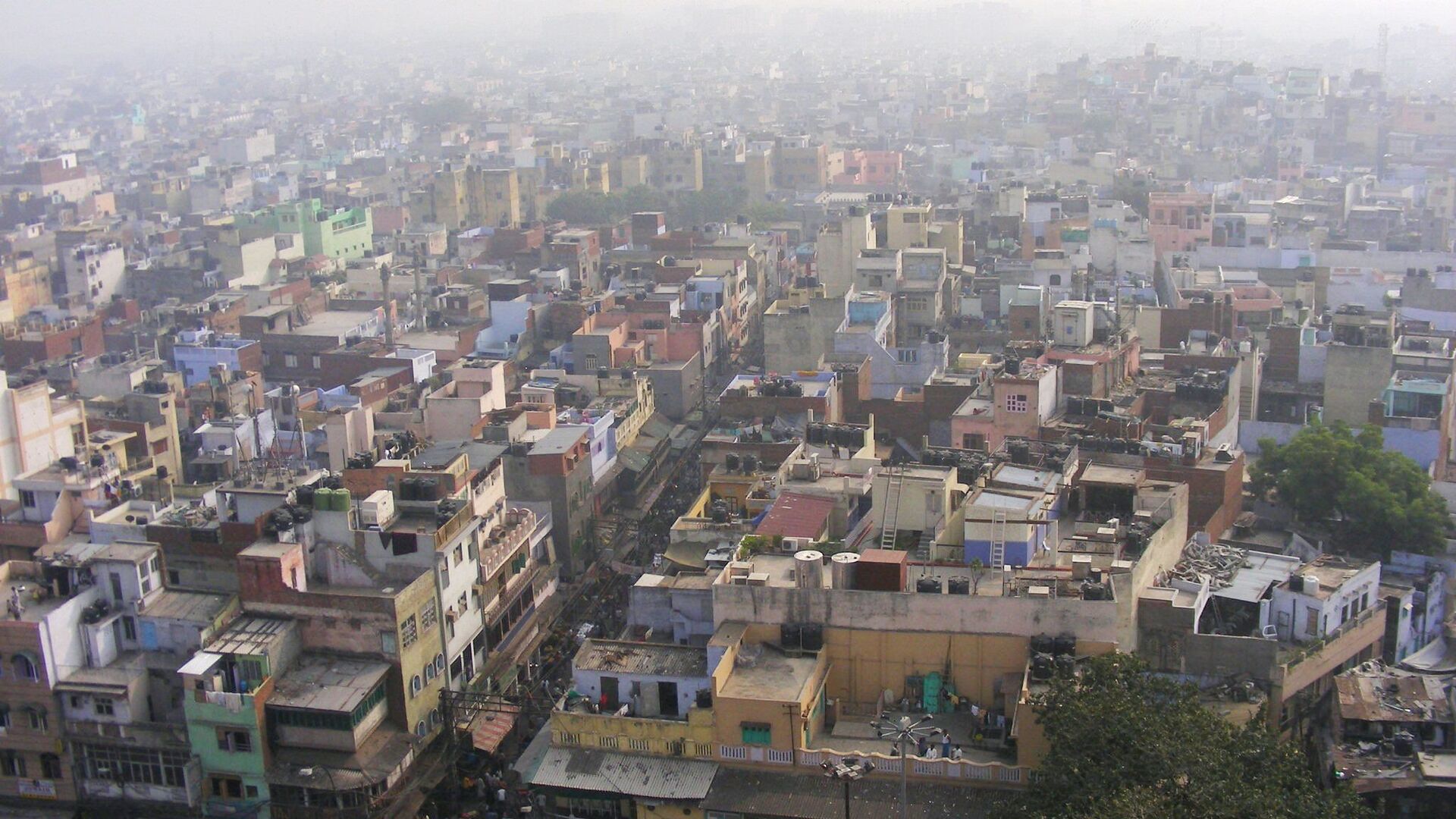https://sputnikglobe.com/20220224/indias-pm-gati-shakti-scheme-to-help-infrastructure-sector-recover-and-grow-pradeep-misra-1093301370.html
India's PM Gati Shakti Scheme to Help Infrastructure Sector Recover and Grow: Pradeep Misra
India's PM Gati Shakti Scheme to Help Infrastructure Sector Recover and Grow: Pradeep Misra
Sputnik International
The infrastructure sector of India is one of the key drivers in the nation's economy. The COVID pandemic, however, has significantly impacted infrastructure... 24.02.2022, Sputnik International
2022-02-24T04:00+0000
2022-02-24T04:00+0000
2022-12-10T11:40+0000
infrastructure
infrastructure
nirmala sitharaman
economy
economy
business projects
finance minister
finance minister
finance
business
https://cdn1.img.sputnikglobe.com/img/107829/51/1078295188_0:192:2048:1344_1920x0_80_0_0_25e5721a81c870b93fb1b42712e958ca.jpg
While presenting the 2022 budget in the Indian parliament on 1 February, federal Finance Minister Nirmala Sitharaman laid emphasis on the country's infrastructure sector. The budget aims to provide a blueprint to steer the Indian economy for the next 25 years under the aegis of PM Gati Shakti -- the country's master plan for multi-modal connectivity, essentially a digital platform to bring 16 ministries, including the railways and the roadways, together for an integrated planning and coordinated implementation of infrastructure connectivity projects.Sputnik interacted with Pradeep Misra, the chairman-cum-managing director of Rudrabhishek Enterprises Limited (REPL) -- a Delhi-based urban development and infrastructure consultancy working on various government projects.In his interview, Misra talked about the roadmap for the recovery of the sector in the post-pandemic era, sustainable infrastructure development, and other issues.Sputnik: The pandemic brought the infrastructure sector nearly to a halt. What are the expectations and the roadmap for the post-pandemic recovery?Pradeep Misra: The pandemic indeed seized the world economy at large for a period. However, on a very quick turnaround time, the infrastructure projects were brought back on track in India. From the very beginning, the federal and state governments recognised the infrastructure sector as the main driver of reversing the negative GDP growth.The government of India has launched various schemes like the National infrastructure Pipeline, asset monetisation, and the PM Gati Shakti scheme to help the infrastructure sector recover and grow. Not only will these programmes bring capital to the system, but also will streamline the processes to make projects more efficient.Sputnik: There has been a lot of focus on sustainable infrastructure development. However, sustainability comes at a financial cost. How does the infrastructure industry see it? Is it a deterrent or a booster for the growth of the sector?Pradeep Misra: Sustainability in the short run indeed looks expensive; however, in the long run, most sustainable developments pay for themselves. Green and reclaimed construction materials, energy-efficient equipment, alternative sources of energy, etc. are one-time investments that have given socio-economic dividends for long periods.Sustainable development is not at all a deterrent for the infrastructure sector, as purpose-driven projects are in higher demand. As the ESG revolution is gathering momentum in the country, projects that care for the ecology and the environment will find it easier to attract financers.More importantly, as a responsible sector, we are taking into account what we are leaving for our coming generations; therefore the additional cost of sustainability doesn’t feel like an extra burden. As more R&D is happening and government support is pouring in, the cost of sustainable developments will soon be as much, if not less, as the traditional developments.Sputnik: The government of India is trying to bring back the Build, Operate, Transfer (BOT) mode of infrastructure financing. How do you see it?Pradeep Misra: India is currently seeing infrastructure development in all directions and dimensions. At a time when other models for private participation are also maturing, BOT is making a comeback. Earlier, the BOT model faced issues due to lengthy and often confusing procedures. The policies regulating BOT often changed, thus discouraging the private players. However, things are different now. There is stability in the policies governing the infrastructure sector. The PM Gati Shakti scheme is all set to make procedures simpler and clearer. Therefore, I believe, BOT is coming back for good.Sputnik: The PM Gati Shakti scheme is very ambitious. How well do you think it can solve the issues faced by the infrastructure sector?Pradeep Misra: The biggest hurdle faced by India’s infrastructure development sector has been the sluggishness of the process and the multiplicity of approval. The PM Gati Shakti Scheme will create a common platform to bring 16 ministries together for faster approvals and better coordination between the departments. It will also provide the technological backbone for the infrastructure sector. As processes become smooth and efficient, raising capital for the sector will become much easier.Sputnik: Apart from the challenges faced during the pandemic, what other roadblocks do you see for the infrastructure sector in the time to come and what are the expectations from the government?Pradeep Misra: Unless something unprecedented like COVID-19 comes, I don’t see any major roadblocks for the infrastructure sector in the country. Complexity and overlapping of procedures have been one of the major issues faced by the sector in the country. The PM Gati Shakti plan is expected to remove this hurdle efficiently.Infrastructure companies have been facing difficulty in raising funds. With the government increasing this CAPEX in the sector, bringing BOT back, and easing the norms for raising capital, this problem is also gradually going away. We expect the government to continue with the current policy regime so that investors and developers can plan for the long run.
Sputnik International
feedback@sputniknews.com
+74956456601
MIA „Rossiya Segodnya“
2022
Rahul Trivedi
https://cdn1.img.sputnikglobe.com/img/07e5/05/12/1082926121_0:-1:627:627_100x100_80_0_0_d882e1a63f627c25b7a534fb8b8234d7.jpg
Rahul Trivedi
https://cdn1.img.sputnikglobe.com/img/07e5/05/12/1082926121_0:-1:627:627_100x100_80_0_0_d882e1a63f627c25b7a534fb8b8234d7.jpg
News
en_EN
Sputnik International
feedback@sputniknews.com
+74956456601
MIA „Rossiya Segodnya“
Sputnik International
feedback@sputniknews.com
+74956456601
MIA „Rossiya Segodnya“
Rahul Trivedi
https://cdn1.img.sputnikglobe.com/img/07e5/05/12/1082926121_0:-1:627:627_100x100_80_0_0_d882e1a63f627c25b7a534fb8b8234d7.jpg
infrastructure, infrastructure, nirmala sitharaman, economy, business projects, finance minister, finance minister, finance, business
infrastructure, infrastructure, nirmala sitharaman, economy, business projects, finance minister, finance minister, finance, business
India's PM Gati Shakti Scheme to Help Infrastructure Sector Recover and Grow: Pradeep Misra
04:00 GMT 24.02.2022 (Updated: 11:40 GMT 10.12.2022) The infrastructure sector of India is one of the key drivers in the nation's economy. The COVID pandemic, however, has significantly impacted infrastructure development. India’s government is undertaking all measures to bring the sector back on the road to recovery.
While presenting the 2022 budget in the Indian parliament on 1 February,
federal Finance Minister Nirmala Sitharaman laid emphasis on the country's infrastructure sector.
The budget aims to provide a blueprint to steer the Indian economy for the next 25 years under the aegis of PM Gati Shakti -- the country's master plan for multi-modal connectivity, essentially a digital platform to bring 16 ministries, including the railways and the roadways, together for an integrated planning and coordinated implementation of infrastructure connectivity projects.
Sputnik interacted with Pradeep Misra, the chairman-cum-managing director of Rudrabhishek Enterprises Limited (REPL) -- a Delhi-based urban development and infrastructure consultancy working on various government projects.
In his interview, Misra talked about the roadmap for the recovery of the sector in the post-pandemic era, sustainable infrastructure development, and other issues.
Sputnik: The pandemic brought the infrastructure sector nearly to a halt. What are the expectations and the roadmap for the post-pandemic recovery?
Pradeep Misra: The pandemic indeed seized the world economy at large for a period. However, on a very quick turnaround time, the infrastructure projects were brought back on track in India. From the very beginning, the federal and state governments recognised the infrastructure sector as the main driver of reversing the negative GDP growth.
The government of India has launched various schemes like the National infrastructure Pipeline, asset monetisation, and the
PM Gati Shakti scheme to help the infrastructure sector recover and grow. Not only will these programmes bring capital to the system, but also will streamline the processes to make projects more efficient.
The government’s plan to invest in 25,000 km of highways and rural infrastructure development will further boost the sector. Private developers are investing in new technologies to hasten the pace of infrastructure development. The real estate sector is coming up with new offers and schemes to boost the demand for homes and commercial spaces. The efforts from both the governments and the private sector are showing results and green shoots of recovery are taking firm root.
Sputnik: There has been a lot of focus on sustainable infrastructure development. However, sustainability comes at a financial cost. How does the infrastructure industry see it? Is it a deterrent or a booster for the growth of the sector?
Pradeep Misra: Sustainability in the short run indeed looks expensive; however, in the long run, most sustainable developments pay for themselves. Green and reclaimed construction materials, energy-efficient equipment, alternative sources of energy, etc. are one-time investments that have given socio-economic dividends for long periods.
Sustainable development is not at all a deterrent for the infrastructure sector, as purpose-driven projects are in higher demand. As the ESG revolution is gathering momentum in the country, projects that care for the ecology and the environment will find it easier to attract financers.
More importantly, as a responsible sector, we are taking into account what we are leaving for our coming generations; therefore the additional cost of sustainability doesn’t feel like an extra burden. As more R&D is happening and government support is pouring in, the cost of sustainable developments will soon be as much, if not less, as the traditional developments.
Sputnik: The government of India is trying to bring back the Build, Operate, Transfer (BOT) mode of infrastructure financing. How do you see it?
Pradeep Misra: India is currently seeing infrastructure development in all directions and dimensions.
The government of India has been pumping huge amounts of capital into the sector; however, the government cannot be present everywhere. Private participation is equally important for sustained growth.
At a time when other models for private participation are also maturing, BOT is making a comeback. Earlier, the BOT model faced issues due to lengthy and often confusing procedures. The policies regulating BOT often changed, thus discouraging the private players. However, things are different now. There is stability in the policies governing the infrastructure sector. The PM Gati Shakti scheme is all set to make procedures simpler and clearer. Therefore, I believe, BOT is coming back for good.
Sputnik: The PM Gati Shakti scheme is very ambitious. How well do you think it can solve the issues faced by the infrastructure sector?
Pradeep Misra: The biggest hurdle faced by India’s infrastructure development sector has been the sluggishness of the process and the multiplicity of approval. The PM Gati Shakti Scheme will create a common platform to bring 16 ministries together for faster approvals and better coordination between the departments. It will also provide the technological backbone for the
infrastructure sector. As processes become smooth and efficient, raising capital for the sector will become much easier.
Sputnik: Apart from the challenges faced during the pandemic, what other roadblocks do you see for the infrastructure sector in the time to come and what are the expectations from the government?
Pradeep Misra: Unless something unprecedented like COVID-19 comes, I don’t see any major roadblocks for the infrastructure sector in the country. Complexity and overlapping of procedures have been one of the major issues faced by the sector in the country. The PM Gati Shakti plan is expected to remove this hurdle efficiently.
Infrastructure companies have been facing difficulty in raising funds. With the government increasing this CAPEX in the sector, bringing BOT back, and easing the norms for raising capital, this problem is also gradually going away. We expect the government to continue with the current policy regime so that investors and developers can plan for the long run.



